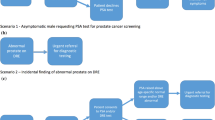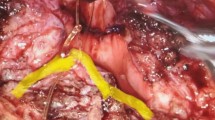Abstract
Transurethral needle ablation (TUNA) of the prostate is an alternative treatment for benign prostatic hyperplasia (BPH) generating temperatures around 100°C leading to necrotic lesions inside the prostate. TUNA is a minimally invasive, low morbidity associated, approach that uses radiofrequency energy. The needles are covered by teflon shields that protect the urethra from thermal injury. Since the introduction of TUNA, there has been a constant upgrading of the device to improve treatment quality. The main advantage of this therapy is the possibility of an outpatient care due to its anaesthesia-free option with a prostatic block. Catheterisation after the procedure is required in 10–40% of cases. Long-term data (5 years) on TUNA demonstrate a sustained improvement of both IPSS score and urinary flow. About a quarter of patients require further intervention at 5 years’ follow-up. The safety profile, along with the significant improvement in both objective and subjective parameters observed after TUNA, makes it an attractive approach for symptomatic BPH.






Similar content being viewed by others
References
Aho TF, Gilling PJ (2003) Laser therapy for benign prostatic hyperplasia: a review of recent developments. Curr Opin Urol 13(1):39–44
Anderson JT, Nickel JC, Marshall VR, Schulman CC, Boyle P (1997) Finasteride significantly reduces acute urinary retention and need for surgery in patients with symptomatic benign prostatic hyperplasia. Urology 49:839
AUA Practice Guidelines Committee (2003) AUA guideline on management of benign prostatic hyperplasia (2003). Chapter 1 diagnosis and treatment recommendations. J Urol 170:530
Blute ML, Larson T (2001) Minimally invasive therapies for benign prostatic hyperplasia. Urol Suppl 58:33
Boyle P, Gould L, Roehrborn C (1996) Prostate volume predicts outcome of treatment of benign prostatic hyperplasia with finasteride. A meta-analysis of randomized clinical trials. Urology 48:398–405
Boyle P, Robertson C, Lowe F, Roehrborn C (2000) Meta-analysis of clinical trials of Permixon in the treatment of BPH. Urology 55:533–539
Boyle P, Robertson C, Manski R, Padley RJ, Roehrborn CG (2001) Meta-analysis of randomized trials of terazosin in the treatment of benign prostatic hyperplasia. Urology 58:717–722
Bruskewitz R, Issa MM, Roehrborn C et al (1998) A prospective, randomised one-year clinical trial comparing transurethral needle ablation to transurethral resection of the prostate for the treatment of symptomatic benign prostatic hyperplasia. J Urol 159:1588–1594
Campo B, Bergamaschi F, Corrada P et al (1997) Transurethral needle ablation (TUNA) of prostate: a clinical and urodynamic evaluation. Urology 49:847–850
Campo B, Muto G, Rigatti P et al (1995) TUNA: clinical reliability of a new procedure for prostatic obstruction treatment. J Urol 153:A1220
Harewood LM, Cleeve KL, O’Connell HE et al (1995) Transurethral needle ablation of prostate (TUNA): clinical results and ultrasound, endoscopic, and histologic findings in pilot study of patients in urinary retention. J Endourol 9:407–412
Harewood LM, Cleeve LK, O’Connell HE, Pope AJ, Vaughan MG (1994) Transurethral Needle Ablation of the prostate (TUNA): a pilot study in patients in acute retention. J Endourol 8:A17–389
Hill B, Belville W, Bruskewitz R, Issa M, Perez-Marrero R, Roehrborn C, Terris M, Naslund M (2004) Transurethral needle ablation versus transurethral resection of the prostate for the treatment of symptomatic benign prostatic hyperplasia: 5-year results of a prospective, randomized, multicenter clinical trial. J Urol 171(6 Pt 1):2336–2340
Kirby RS, Altwein JE, Bartsch G et al (2003) The efficacy and tolerability of doxazosin and finasteride, alone or in combination, in the treatment of symptomatic benign prostatic hyperplasia. results of the prospective European Doxazosin and combination therapy (PREDICT) trial. Urology 61:119–126
Lukacs B, Grange JC, Comet D, McCarthy C (1998) Three year prospective study of 3228 clinical BPH patients treated with alfuzosin in general practice. Prostate Cancer Prostatic Dis 1:276
Lukacs B, Leplege A, Thibault P, Jardin A (1996) Prospective study of men with clinical benign prostate hyperplasia treated with alfuzosin by general practitioners: 1-year results. Urology 48:731
McConnell JD, Roehrborn CG, Bautista OM, Andriole GL Jr, Dixon CM, Kusek JW, Lepor H, McVary KT, Nyberg LM Jr, Clarke HS, Crawford ED, Diokno A, Foley JP, Foster HE, Jacobs SC, Kaplan SA, Kreder KJ, Lieber MM, Lucia MS, Miller GJ, Menon M, Milam DF, Ramsdell JW, Schenkman NS, Slawin KM, Smith JA, Medical Therapy of Prostatic Symptoms (MTOPS) Research Group (2003) The long-term effect of doxazosin, finasteride, and combination therapy on the clinical progression of benign prostatic hyperplasia. N Engl J Med 349(25):2387–2398
McConnell JD, Roehrborn CG, Bautista OM, Andriole GL Jr, Dixon CM, Kusek JW et al (2003) The long-term effect of doxazosin, finasteride, and combination therapy on the clinical progression of benign prostatic hyperplasia. N Engl J Med 349:2387
Mebust WK, Holtgrewe HL, Cockett AT, Peters PC. (1989) Transurethral prostatectomy: immediate and postoperative complications. A cooperative study of 13 participating institutions evaluating 3,885 patients. J Urol 141:243–247
Naslund MJ, Benson RC, Cohen ES, Gutierrez-Aceves J, Issa MM (2000) Transurethral needle ablation (TUNA) for BPH in patients with median lobe enlargement. Report of a prospective multi-centre study. AUA Annual Meeting Clinical Abstracts. Williams & Wilkins/Lippincott, Baltimore/Philadelphia
Naslund MJ, Carlson AM, Williams MJ (2005) A cost comparision of medical management and transurethral needle ablation for the treatment of benign prostatic hyperplasia during 5-year period. J Urol 173:2090–2093
Plentka L, Loghem JV, Hahn E et al (1991) Comorbidities and perioperative complications among patients with surgically treated benign prostatic hyperplasia. Urology 38(Suppl 1):43
Ragavan N, Philip J, Balasubramanian SP, Desouza J, Marr C, Javle P (2005) A randomized, controlled trial comparing lidocaine periprostatic nerve block, diclofenac suppository and both for transrectal ultrasound guided biopsy of prostate. J Urol 174(2):510–513
Ramon J, Lynch TH, Eardley I et al (1997) Transurethral needle ablation of the prostate for the treatment of benign prostatic hyperplasia: a collaborative multicentre study. Br J Urol 80:128–134
Rasor JS, Zlotta AR, Edwards SD, Schulman CC (1993) Transurethral needle ablation: gradient mapping and comparision of lesion size in a tissue model and in patients with benign prostatic hyperplasia. Eur Urol 24:411–414
Roehrborn C, Boyle P, Nickel J, Hoefner K, Andriole G (2002) Efficacy and safety of a dual inhibitor of 5-alpha-reductase types 1 and 2 (dutasteride) in men with benign prostatic hyperplasia. Urology 60:434
Schulman CC, Zlotta AR (1995) Transurethral needle ablation of the prostate for treatment of benign prostatic hyperplasia: early clinical experience. Urology. 45(1):28–33
Schulman CC, Zlotta AR (1995) TUNA: a promising new therapy for BPH. Contemp Urol 7(10):59–60, 62, 64
Steele GS, Sleep DJ (1997) Transurethral needle ablation of the prostate: a urodynamic based study with 2-year followup. J Urol 158(5):1834–1838
Vaughan ED Jr (2003) Medical management of benign prostatic hyperplasia—are two drugs better than one? N Engl J Med 349:2449
Zlotta AR, Djavan B (2002) Minimally invasive therapies for benign prostatic hyperplasia in the new millennium: long-term data. Curr Opin Urol 12:7–14
Zlotta AR, Giannakopoulos X, Maehlum O, Ostrem T, Schulman CC (2003) Long-term evaluation of transurethral needle ablation of the prostate (TUNA) for the treatment of symptomatic benign prostatic hyperplasia: Clinical outcome up to five years from three centers. Eur Urol 44:89–93
Zlotta AR, Peny MO, Matos C, Schulman CC (1996) Transurethral needle ablation of the prostate: clinical experience in patients in urinary acute retention. Br J Urol 77(3):391–397
Zlotta AR, Schulman CC (1999) Interstitial maser coagulation for the treatment of benign prostatic hyperplasia using local anaesthesia only. BJU Int 83(3):341–342
Author information
Authors and Affiliations
Corresponding author
Rights and permissions
About this article
Cite this article
Barmoshe, S., Zlotta, A.R. How do I treat and follow my TUNA patients. World J Urol 24, 397–404 (2006). https://doi.org/10.1007/s00345-006-0091-1
Received:
Accepted:
Published:
Issue Date:
DOI: https://doi.org/10.1007/s00345-006-0091-1




